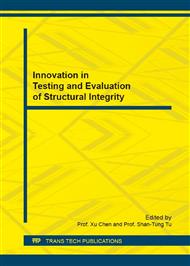p.22
p.28
p.33
p.41
p.46
p.51
p.57
p.62
p.67
Effect of Various Side Grooves on 3D Crack-Front J-Integral for CT Specimens
Abstract:
Three-dimensional (3D) elastic-plastic finite element model (FEM) is adopted to research the effect of side groove on the crack-front J-integral for different size of Compact Tension (CT) specimens. Although the side-grooved CT specimen is widely used in the existing test method, such as ASTM E1820-13, the test data of fracture toughness is varying with the various geometric parameters. Before FE calculation, the material properties of Q345 steel were obtained by uniaxial tensile test, especially for the true stress-strain relationship. In this paper, it focuses on the numerical study of geometric parameter effects on the fracture toughness. Toward this end, the commercial FE software of ABAQUS is adopted to calculate the J-integral. Since the side groove of CT specimen is so important to make the fracture test success, the various parameters of side groove is intensively analyzed for obtaining the accurate J-integral along the crack front, including the effects of the angle, depth and root radius. In fact, the side groove effect is so significant around the crack front that cannot be ignored in the J-integral calculation. Through rigorous FE investigation, the influence of the side groove on the fracture toughness testing is fully disclosed, and the appropriate side groove configuration is recommended accordingly.
Info:
Periodical:
Pages:
46-50
Citation:
Online since:
September 2016
Authors:
Price:
Сopyright:
© 2017 Trans Tech Publications Ltd. All Rights Reserved
Share:
Citation:


